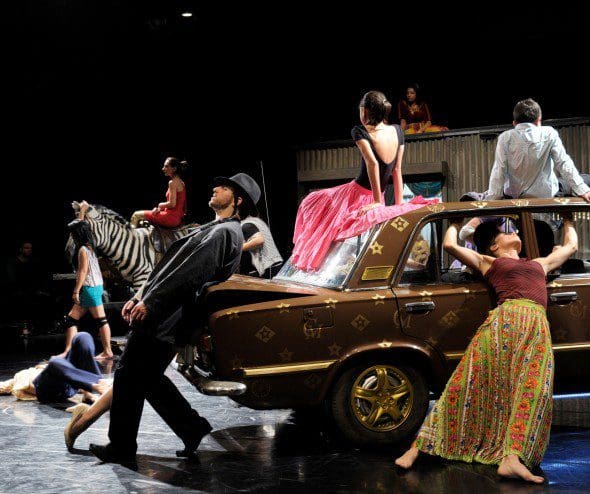 What we learn of the Romani is limited but what is limited in the LIFT Festival’s Open For Everything is probed deeply in dance rather than storytelling, a bracing experience when done well. Constanza Macras’ dance company has made a piece that celebrates and explains the ‘last nomadic tribe in Europe’, the Romani. While light on explanation, celebration is intense without cloying; Macras has stressed her desire to avoid ‘commiseration’ as the piece’s dynamic and this will is mostly realised. A stuffed, Louis Vuitton-decked hatchback rides onstage. Men and women flow out while others pop out from the wings, filling the stage in a formless mass. They sing, they dance, they play instruments and they tell stories.
What we learn of the Romani is limited but what is limited in the LIFT Festival’s Open For Everything is probed deeply in dance rather than storytelling, a bracing experience when done well. Constanza Macras’ dance company has made a piece that celebrates and explains the ‘last nomadic tribe in Europe’, the Romani. While light on explanation, celebration is intense without cloying; Macras has stressed her desire to avoid ‘commiseration’ as the piece’s dynamic and this will is mostly realised. A stuffed, Louis Vuitton-decked hatchback rides onstage. Men and women flow out while others pop out from the wings, filling the stage in a formless mass. They sing, they dance, they play instruments and they tell stories.
There is a messiness present that will deter some. DorkyPark puts pros with non-pros and the pros are easily discernible. Nevertheless, Maracas’ method amounts to a balancing act, one that, occasionally so neat, obscures the mix of skill. This is clear in the simpler numbers yet simple is not necessarily worse than byzantine: the plain, choreographed heftiness that matches Adele’s Rolling in the Deep sits equally with the breakneck Romani footwork. I hesitate identifying a single style because Open For Everything is catholic and this shines through its assimilation of tradition; floorwork, pugnacity and rapid hand-to-leg slaps form a mesmeric vision at times. This shows in a segment I dub ‘Versace’: while the band sings the various designer brand names the cast strip and share clothing, concurrently moving as a vivid, almost orgiastic, array. It flawlessly exhibits the simultaneous oneness and changeability of the Romani community.
Not all features are wonderful explication, however: some of dramaturg Carmen Mehnert’s techniques lean toward ‘commiseration’; the use of an antiziganist German to give contemporary and historical context is egregious. Additionally, elements like the Ugly American who highlights the world’s cultural misconceptions fall flat considering the sensory revelation of Macras’ choreography. The intermittent stories of the cast, while verbatim, further lack the kinaesthetic potency of the dancing and reveal little new information.
Further reading should follow Open for Everything. Its boldest move is to tell more through movement than in word and should inspire research, not least of all to counter the common nomadic stereotypes. While not a work of perfect cohesion, Macras and her cast impress indelibly when given the opportunity.
